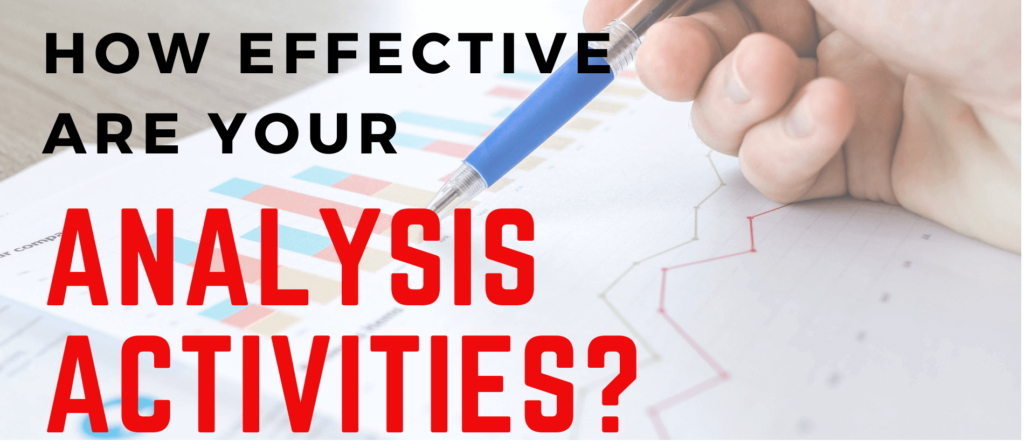
We analysts conduct a plethora of analysis activities through the life cycle of our projects. However, have you ever stopped and asked how effective are your analysis activities?
That’s precisely what we are going to learn today – How to carefully assess the effectiveness of your analysis activities.
The complete exercise is divided into two parts. We first start with measuring your activities’ performance and then assess the results.
Let’s jump right into it!
Measuring Analysis Activities’ Performance
There exist several ways to measure whether the analysis activities you perform on your project are efficient and headed in the right direction. Let’s discuss them one by one:
1. Surveys/Interviews/Polls/Questionnaire: It is recommended to get the feedback of the project stakeholders about how the analysis activities are being carried out. They may point out whether they are satisfied with the mode of elicitation, documentation, and communication, or they expect some improvements. Also, we should try to discover their overall outlook towards the project by asking questions like:
- Did you feel involved in the project right from its initiation?
- Were you periodically informed about the project progress and changes?
- Were your suggestions and comments valued?
- Were the analysis meetings organized and constructive?
Periodically conducting such assessments ensures that the project stakeholder’s needs and expectations are met, and they feel their voices are heard and respected.
2. Process Review: Reviewing the existing project processes will uncover insights about their performance and ensure that the strategy aligns with the needs of the project and its stakeholders.
Some notable processes that are good contenders for process review are: Requirements Gathering and Elicitation Process, Documentation Process, Requirements Verification & Validation process, Communication Process, and Change Management Process.
While conducting a process review, identify the need behind defining the process, the elements contained within the process, and question whether the process is, in reality, benefitting your project?
I have seen many Business Analysts and Project Managers blindly following organizational processes without tailoring/modifying them as per their projects!
3. Metrics and KPIs: Usually, metrics and Key Performance Indicators (KPI) for measuring the analysis activities are decided in the planning phase of a project. They later help gauge the performance of the analysis efforts. These KPIs are:
- Requirements Conformity (i.e., percentage of requirements conforming to the project scope)
- Requirements Defect Density
- Customer Satisfaction Ratings (against the requirements)
- Timely Reception (i.e., reception of deliverables within the timelines)
4. Variance Analysis: Variance denotes the ‘gap between the planned and actual results’, and variance analysis is carried out to measure the discrepancy between the project’s planned and actual performance parameters.
Variance analysis may be conducted against critical project areas like scope, time/schedule, cost, quality, risk, resources, customer satisfaction, and procurement. Once the variance is found, it’s duly analyzed for its cause, effects, and then the respective corrective and preventive action should be taken to bring the project back on track.
5. Alignment to business need and scope: All the requirements, analysis, and documents in a project should be aligned towards balancing and achieving the business need.
It should be measured whether there were any deviations from the requirement scope:
- Did the requirement elicitation exercise miss capture some requirements?
- Were there additional requirements added that were not in the project scope?
Also, it should be noted whether the current requirements are in line with the contractual agreement and obligations or there is a disparity? Measuring such analytics at regular intervals will guarantee the project remains on track while keeping scope creeps at bay.
Reporting Analysis Results
1. Performance Assessment Results: Once the performance of a project’s analysis efforts is measured, it is documented in a performance assessment report which contains:
- the current processes being followed,
- level of effectiveness of those processes,
- current performance of the project,
- existing issues and concerns,
This report is usually prepared by the project manager and is also shared with the key stakeholders to update them about the current status of the project’s performance.
Suppose the performance assessment results are below thresholds, the project PM, along with the primary stakeholders, defines a remediation plan that states what steps are to be taken in order to improve the project’s performance and what are the process enhancements/modifications required?
2. Trends and Variance report: While executing and controlling a project, the trends of the project’s vitals are constantly monitored, and a trend report is prepared, indicating the pattern followed by the project’s performance. Additionally, as explained before, variance analysis is also conducted, and a variance report is prepared which documents the:
- areas in which a variance is observed,
- the root cause of the variance,
- how the variance is to be minimized and
- preventive actions that must be taken to ensure that the variance doesn’t re-occur in the future phases of the project.
3. Lessons learned: A fundamental and successful way to ensure that the project’s issues and problems don’t resurface is by documenting them in its lessons learned document. Every project has several lessons discovered in different phases, and they are correctly documented in an organization’s knowledge base repository. Whenever a new project/ phase is being started, these lessons learned documents are referred to to understand the issues and problems faced by similar projects before and how to create or modify the existing project plans or processes to ensure that the project stays right on track.
Peter Drucker once said, ‘What gets measured, gets managed’ – make sure you measure how efficient your analysis is and help your PM better manage your project. Since you, along with your objectives, are helping him achieve his goals, you will, for sure, be the star performer in your PM’s eyes.
So go, Become One.
